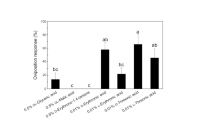Abstract
Avoidance ofErysimum cheiranthoides for oviposition byPieris rapae has been attributed to the presence of water-soluble deterrents. The active material was extracted inton-butanol and isolated by a series of HPLC separations. TLC of the active fraction and visualization of individual constituents with Kedde's reagent indicated that cardenolides are responsible for deterring oviposition. UV spectra were also characteristic of cardenolides. Bioassays of selected known cardenolides revealed a general lack of activity, except for cymarin, which was as strongly deterrent as the most prominent cardenolide isolated in pure form fromE. cheiranthoides. The results suggest that cardenolides in this plant can explain its escape from cabbage butterflies, but specific structural features of the glycosides are necessary for oviposition-deterring activity.
Similar content being viewed by others
References
Boodley, J.W., andSheldrake, R. 1977. Cornell peat-lite mixes for commercial plant growing.Cornell Inf. Bull. 42:1–8.
Feeny, P. 1977. Defensive ecology of the Cruciferae.Ann. Mo. Bot. Gard. 64:221–234.
Krebs, K.G., Heusser, D., andWimmer, H. 1969. Spray reagents, pp. 854–911,in (E. Stahl (ed.). Thin-Layer Chromatography (English Translation). Springer-Verlag, Berlin.
Lundgren, L. 1975. Natural plant chemicals acting as oviposition deterrents on cabbage butterflies [Pierisbrassicae (L.),P. rapae (L.), andP. napi (L.)].Zool. Scr. 4:253–258.
Ma, W.C., andSchoonhoven, L.M. 1973. Tarsal contact chemosensory hairs of the large white butterfly,Pieris brassicae and their possible role in oviposition behavior.Entomol. Exp. Appl. 16:343–357.
Nielsen, J.K. 1978. Host plant discrimination within Cruciferae: Feeding responses of four leaf beetles (Coleoptera: Chrysomelidae) to glucosinolates, cucurbitacins and cardenolides.Entomol. Exp. Appl. 24:41–54.
Renwick, J.A.A., andRadke, C.D. 1985. Constituents of host and non-host plants deterring oviposition by the cabbage butterfly,Pieris rapae.Entomol. Exp. Appl. 39:21–26.
Renwick, J.A.A., andRadke, C.D. 1987. Chemical stimulants and deterrents regulating acceptance or rejection of crucifers by cabbage butterflies.J. Chem. Ecol. 13(7): 1771–1775.
Richards, O.W. 1940. The biology of the small white butterfly (Pieris rapae), with special reference to the factors controlling its abundance.J. Anim. Ecol. 9:243–288.
Rodman, J.E., andChew, F.S. 1980. Phytochemical correlates of herbivory in a community of native and naturalized Cruciferae.Biochem. Syst. Ecol. 8:43–50.
Rodman, J., Brower, L., andFrey, J. 1982. Cardenolides in North AmericanErysimum (Cruciferae), a preliminary chemotaxonomic report.Taxon 31:507–516.
Rothschild, M., Alborn, H., Stenhagen, G., andSchoonhoven, L.M. 1988. A strophanthidine glycoside in the Siberian wallflower: A contact deterrent for the large white butterfly.Phytochemistry 27(1): 101–108.
Schoonhoven, L.M. 1972. Secondary plant substances and insects.Recent Adv. Phytochem. 5:197–224.
Singh, B., andRastogi, R.P. 1970. Cardenolides—glycosides and genins.Phytochemistry 9:315–331.
Usher, B.F., andFeeny, P. 1983. Atypical secondary compounds in the family Cruciferae: Tests for toxicity toPieris rapae, an adapted crucifer-feeding insect.Entomol. Exp. Appl. 34:257–265.
Verschaffelt, E. 1911. The cause determining the selection of food in some herbivorous insects.Proc. Acad. Sci. Amsterdam. 13:536–542.
Author information
Authors and Affiliations
Rights and permissions
About this article
Cite this article
Renwick, J.A.A., Radke, C.D. & Sachdev-Gupta, K. Chemical constituents ofErysimum cheiranthoides deterring oviposition by the cabbage butterfly,Pieris rapae . J Chem Ecol 15, 2161–2169 (1989). https://doi.org/10.1007/BF01014106
Received:
Accepted:
Issue Date:
DOI: https://doi.org/10.1007/BF01014106




